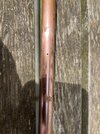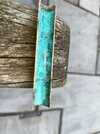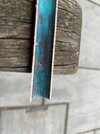You are using an out of date browser. It may not display this or other websites correctly.
You should upgrade or use an alternative browser.
You should upgrade or use an alternative browser.
Leaks in copper pipe…..
- Thread starter Heatslave
- Start date
Sponsored Links
Is it a case that the older pipe is thicker ? Or is the new stuff somehow inferior copperMy copper is around 40 years, maybe on borrowed time..
I have never given it a thought that a new length of pipe could have pinholes in it. From now on I will be examining each length very carefully.
But how other than by eye, cap the end and attach a hose pipe to the other and try and get some pressure in there ?
But then the OP problems were not evident on commission.
Is it a case that the older pipe is thicker ? Or is the new stuff somehow inferior copper
I have never given it a thought that a new length of pipe could have pinholes in it. From now on I will be examining each length very carefully.
But how other than by eye, cap the end and attach a hose pipe to the other and try and get some pressure in there ?
But then the OP problems were not evident on commission.
I’ve been working with copper pipe as a DIY’er for 23 years, and the new stuff is sh!te compared to the old stuff. You can physically see the wall is thinner
Sponsored Links
- Joined
- 8 May 2017
- Messages
- 9,924
- Reaction score
- 2,542
- Country

Copper pipe corrosion ,internally, forms the series of small lumps that you see inside the pipe. This is commonly known as "pitting". The exact cause of pitting is largely unknown,although many theories exist ,which include (to name just a few), water quality and the chemicals present in potable water with varying pH levels, residual flux left in pipework, electrolytic charges present, poor quality copper tube with high levels of carbon content. Much research has been done on the issue , particularly in America, (where in certain areas the problem is rife ,and pin hole leaks appearing within months of installation ). Unfortunately ,to the best of my knowledge,no single factor has been identified as the root cause.
Copper pipe corrosion ,internally, forms the series of small lumps that you see inside the pipe. This is commonly known as "pitting". The exact cause of pitting is largely unknown,although many theories exist ,which include (to name just a few), water quality and the chemicals present in potable water with varying pH levels, residual flux left in pipework, electrolytic charges present, poor quality copper tube with high levels of carbon content. Much research has been done on the issue , particularly in America, (where in certain areas the problem is rife ,and pin hole leaks appearing within months of installation ). Unfortunately ,to the best of my knowledge,no single factor has been identified as the root cause.
Thanks for the info
I’ve sent a sample off to Wednesbury, see what they make of it. But after only two years after installation ?? I just don’t get it ??
And with more of the same copper upstairs, in both the heating and hot / cold water systems, it’s only a matter of time before that goes too. An expensive ticking time bomb
I work mostly in a area where the water is described as aggressively hard .
See pinholes in copper fairly regularly properties with water softeners seem to get way less.
Copper cylinders don't last long either we now use stainless steel replacement cylinders.
See pinholes in copper fairly regularly properties with water softeners seem to get way less.
Copper cylinders don't last long either we now use stainless steel replacement cylinders.
Yeah, I’m up in Hartlepool. Our water is very hard. And I’ve got a combimate fitted.I work mostly in a area where the water is described as aggressively hard .
See pinholes in copper fairly regularly properties with water softeners seem to get way less.
Copper cylinders don't last long either we now use stainless steel replacement cylinders.
As mentioned previously, I’ve never had an issue in 23 years, and still have 23 year old copper in the house. I just think this modern stuff is sh!te, but I’m only a DIY’er, not a pro, so I don’t really know
DIYnot Local
Staff member
If you need to find a tradesperson to get your job done, please try our local search below, or if you are doing it yourself you can find suppliers local to you.
Select the supplier or trade you require, enter your location to begin your search.
Please select a service and enter a location to continue...
Are you a trade or supplier? You can create your listing free at DIYnot Local
Sponsored Links
Similar threads
- Replies
- 18
- Views
- 3K
- Replies
- 8
- Views
- 956
- Replies
- 4
- Views
- 8K



